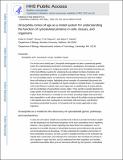Drosophila comes of age as a model system for understanding the function of cytoskeletal proteins in cells, tissues, and organisms
Author(s)
Rodal, Avital A.; Del Signore, Steven J.; Martin, Adam C
DownloadMartin_Drosophila comes.pdf (1.952Mb)
OPEN_ACCESS_POLICY
Open Access Policy
Creative Commons Attribution-Noncommercial-Share Alike
Terms of use
Metadata
Show full item recordAbstract
For the last 100 years, Drosophila melanogaster has been a powerhouse genetic system for understanding mechanisms of inheritance, development, and behavior in animals. In recent years, advances in imaging and genetic tools have led to Drosophila becoming one of the most effective systems for unlocking the subcellular functions of proteins (and particularly cytoskeletal proteins) in complex developmental settings. In this review, written for non-Drosophila experts, we will discuss critical technical advances that have enabled these cell biological insights, highlighting three examples of cytoskeletal discoveries that have arisen as a result: (1) regulation of Arp2/3 complex in myoblast fusion, (2) cooperation of the actin filament nucleators Spire and Cappuccino in establishment of oocyte polarity, and (3) coordination of supracellular myosin cables. These specific examples illustrate the unique power of Drosophila both to uncover new cytoskeletal structures and functions, and to place these discoveries in a broader in vivo context, providing insights that would have been impossible in a cell culture model or in vitro. Many of the cellular structures identified in Drosophila have clear counterparts in mammalian cells and tissues, and therefore elucidating cytoskeletal functions in Drosophila will be broadly applicable to other organisms.
Description
available in PMC 2016 June 30
Date issued
2015-05Department
Massachusetts Institute of Technology. Department of BiologyJournal
Cytoskeleton
Publisher
John Wiley & Sons, Inc.
Citation
Rodal, Avital A., Steven J. Del Signore, and Adam C. Martin. “Drosophilacomes of Age as a Model System for Understanding the Function of Cytoskeletal Proteins in Cells, Tissues, and Organisms.” Cytoskeleton 72, no. 5 (May 2015): 207–224.
Version: Author's final manuscript
ISSN
19493584